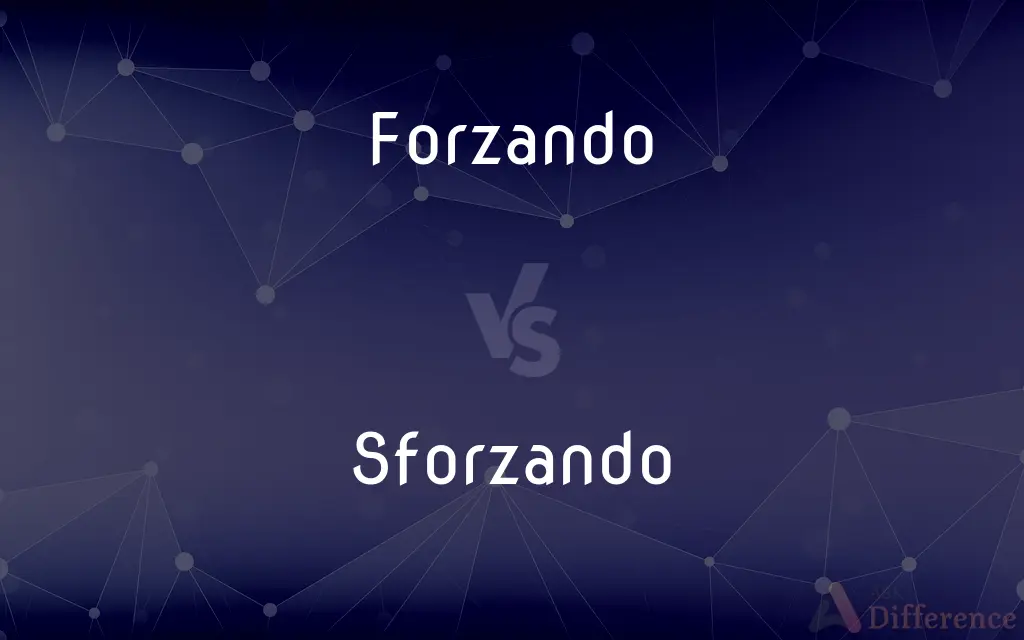Forzando vs. Sforzando — What's the Difference?
By Fiza Rafique & Maham Liaqat — Updated on April 7, 2024
Forzando and sforzando are musical terms used to indicate a sudden increase in loudness, but "sforzando" is more commonly used and specifically denotes a forceful, sudden emphasis on a note or chord.

Difference Between Forzando and Sforzando
Table of Contents
ADVERTISEMENT
Key Differences
Forzando, often abbreviated as "fz," is a term that implies forcing or emphasizing a note or chord to stand out within a musical piece, suggesting a momentary increase in intensity. Sforzando, abbreviated as "sfz," "sffz," or "sf," directly translates to "sudden force" and is widely recognized in musical notation for its explicit instruction to play a note or chord with a strong, sudden emphasis, making it momentarily the focal point of the performance.
The use of forzando is less common in contemporary music notation and discussions, possibly due to its overlap with sforzando in both meaning and effect. Sforzando, however, has a more pronounced presence in scores and musical instruction, often employed by composers to convey a dramatic, forceful punch within a sequence, thereby contributing significantly to the dynamic contour of a piece.
Both terms serve to enrich the expressive quality of music, allowing performers to inject a marked intensity into a composition. However, sforzando is more likely to be encountered by musicians due to its specificity and the clarity it provides in conveying the composer's intent for a sudden, pronounced dynamic change.
While forzando and sforzando are conceptually similar, the preference and frequency of use in musical scores tend to favor sforzando, underscoring its role in enhancing the dramatic expression and textual depth of a piece. This preference does not diminish the relevance of forzando but highlights sforzando’s prominence in musical dynamics.
The distinction between forzando and sforzando may vary among performers and conductors, with interpretation influenced by the context of the piece, the overall dynamic range, and the specific instructions or traditions of the music genre. Both terms underscore the importance of dynamic variation as a tool for emotional expression and narrative depth in music.
ADVERTISEMENT
Comparison Chart
Definition
Indicates forcing or emphasizing a note/chord.
Denotes a strong, sudden emphasis on a note or chord.
Abbreviation
Fz
Sfz, sffz, sf
Usage
Less common, overlaps with sforzando.
More common, specific instruction for sudden emphasis.
Effect
Momentary increase in intensity.
Dramatic, forceful punch within a sequence.
Presence in Scores
Rarely seen in contemporary music notation.
Widely used, clear in conveying dramatic dynamic changes.
Interpretation
May vary, generally implies a notable emphasis.
Explicitly instructs a sudden, forceful emphasis.
Role in Music
Enhances expressive quality, allows for intensity.
Contributes to dynamic contour, emphasizes dramatic expression.
Compare with Definitions
Forzando
Less Common Use.
Modern scores rarely feature forzando, opting for more specific dynamics.
Sforzando
Dramatic Emphasis.
The sforzando in the symphony’s opening grabs the audience's attention.
Forzando
Intensity Marker.
The composer used forzando to highlight the climax of the piece.
Sforzando
Dynamic Contrast.
Sforzando creates stark contrasts, vital for the piece's emotional impact.
Forzando
Expressive Quality.
Forzando passages require careful control to maintain musicality.
Sforzando
Widely Recognized.
Musicians frequently encounter sforzando, practicing its precise execution.
Forzando
Variant of sforzando.
Sforzando
Suddenly or strongly accented. Used chiefly as a direction.
Forzando
See Sforzato.
Sforzando
A sforzando tone or chord.
Sforzando
(music) A mark that indicates that a note is to be played with a strong initial attack.
Sforzando
(music) A passage having this mark.
Sforzando
(music) Played in this style.
Sforzando
(music) Describing a passage having this mark.
Sforzando
Forcing or forced; - a direction placed over a note, to signify that it must be executed with peculiar emphasis and force; - marked fz (an abbreviation of forzando), sf, sfz, or .
Sforzando
An accented chord
Sforzando
(music) a notation written above a note and indicating that it is to be played with a strong initial attack
Common Curiosities
Can forzando and sforzando be used interchangeably?
While conceptually similar, sforzando is more specific and commonly used in scores.
How is sforzando used by composers?
Composers use sforzando for a sudden, forceful emphasis, adding drama and contrast to a piece.
What does a sforzando indication look like in musical notation?
It’s typically indicated by “sfz,” “sffz,” or “sf” above or below the staff.
What impact does sforzando have on the listening experience?
It creates moments of surprise and intensity, enriching the musical narrative and emotional depth.
How do dynamics like forzando and sforzando contribute to a performance?
They add expressive depth and variation, allowing performers to convey nuanced emotional states.
Is there a difference in dynamics between forzando and sforzando?
Both indicate a dynamic increase, but sforzando often implies a more dramatic and sudden emphasis.
What does forzando signify in music?
Forzando indicates a forced emphasis on a note or chord, suggesting a brief surge in intensity.
How do performers approach a sforzando?
Performers give a pronounced, abrupt increase in volume to the marked note or chord.
Why might a composer choose forzando over sforzando?
Composer choice may depend on tradition, desired effect, or personal preference, though sforzando is more prevalent.
What's the best way to practice sforzando passages?
Practice with focused bursts of volume, ensuring control and precision without sacrificing tone quality.
Share Your Discovery

Previous Comparison
Buffet vs. Brunch
Next Comparison
Entirety vs. TotalityAuthor Spotlight
Written by
Fiza RafiqueFiza Rafique is a skilled content writer at AskDifference.com, where she meticulously refines and enhances written pieces. Drawing from her vast editorial expertise, Fiza ensures clarity, accuracy, and precision in every article. Passionate about language, she continually seeks to elevate the quality of content for readers worldwide.
Co-written by
Maham Liaqat














































